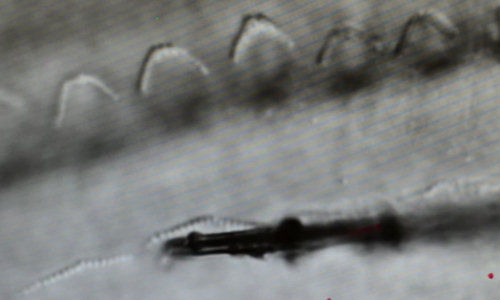Stanford researchers have received Bio-X funding to develop a tiny moving probe to study the mechanical properties of sensory cells in the ear. Their research could lead to new treatments for hearing loss, and the probe may advance other scientists’ research as well.
Much of what is known about sensory touch and hearing cells is based on indirect observation. Scientists know that these exceptionally tiny cells are sensitive to changes in force and pressure. But to truly understand how they function, scientists must be able to manipulate them directly. Now, Stanford scientists are developing a set of tools that are small enough to stimulate an individual nerve or group of nerves, but also fast and flexible enough to mimic a realistic range of forces.
A team of mechanical engineers from Stanford and ear specialists from the Stanford School of Medicine is developing a new device, known as a force probe, that allows the researchers to study the flexible hair cells that translate sound waves into electrical signals. The probe works at a range of frequencies that are more realistic to human hearing than previous machines.
Our ability to interpret sound is largely dependent on bundles of thousands of tiny hair cells that get their name from the hair-like projections on their top surfaces. As sound waves vibrate the bundles, they force proteins in the cells’ surfaces to open and allow electrically charged molecules, called ions, to flow into the cells. The ions stimulate each hair cell, allowing it to transfer information from the sound wave to the brain. Hair bundles are more sensitive to particular frequencies of sound, which allows us to tell the difference between a siren and a subwoofer.
People with damaged or congenital defects in these delicate hair cells suffer from severe, irreversible hearing loss. Scientists remain unsure how to treat this form of hearing loss because they do not know how to repair or replace a damaged hair cell. Physical manipulation of the cells is key to exploring the fine details of how they function. This new probe is the first tool nimble enough to do it.
Beth Pruitt, an associate professor of mechanical engineering, and researchers in her Stanford Microsystems Lab have been working to develop electromechanical devices for use as high-speed force probes. The tool, developed with funding from Stanford’s Bio-X program, vibrates the hair cells to mimic the effect of incoming sound waves. This allows the researchers to study the cause-and-effect relationships between the forces exerted in hair cells by sound waves and the electrical signals they produce in response.
The new force probe represents several advantages over traditional glass force probes. At 300 nanometers thick, Pruitt’s probe is just three-thousandths the width of a human hair. Made of flexible silicon, the probe can mimic a much wider range of sound wave frequencies than rigid glass probes, making it more practical for studying hearing. The probe also measures the force it exerts on hair cells as it pushes, a new achievement for high-speed force probes at such small sizes.
Manipulating the probe requires a gentle touch, said Pruitt’s collaborator, Anthony Ricci, a professor of otolaryngology at the Stanford School of Medicine. The tissue samples – in this case, hair cells from a rat’s ear – sit under a microscope on a stage floating on a cushion of air that keeps it isolated from vibrations.
The probe is controlled using three dials that function similarly to an Etch-a-Sketch. The first step of the experiment involves connecting a tiny, delicate glass electrode to the body of a single hair cell.
Using a similar manipulator, Ricci and his team then press the force probe on a single hair cell, and the glass electrode records the changes in the cell’s electrical output. Pruitt and Ricci say that understanding how physical changes prompt electrical responses in hair cells can lead to a better understanding of how people lose their hearing following damage to the hair cells.
The force probe has the potential to catalyze future research on sensory science, Ricci said.
Up to now, limits in technology have held scientists back from understanding important functions such as hearing, touch, and balance. Like hair cells in the ear, cells involved in touch and balance react to the flexing and stretching of their cell membranes. The force probe can be used to study those cells in the same manner that Pruitt and Ricci are using it to study hair cells.
Understanding the mechanics of how cells register these sensory inputs could lead to innovative new treatments and prosthetics. For example, Pruitt and Ricci think their research could help bioengineers build a better hair cell for people with impaired hearing from damage to their natural hair cells.
Their efforts to build the probe are funded by Stanford’s Bio-X Interdisciplinary Initiatives Program (Bio-X IIP), which provides money for interdisciplinary projects that have potential to improve human health in innovative ways. Bio-X seed grants have funded 141 research collaborations connecting hundreds of faculty since 2000. The proof-of-concept projects have produced hundreds of science publications, dozens of patents, and more than a tenfold return on research funds to Stanford.
“This project came about because collaborations are so open and available at Stanford. I’m not an engineer, so I couldn’t design this myself. Beth is not a biologist, so she wouldn’t have the applications for it,” Ricci said. “But together we can take both of our strengths and put it together, and Stanford is an unusual place because it actually fosters that interaction.”
Story Source:
The above story is based on materials provided by Standford.





